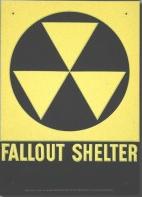|
Steve McGill is the winner. Orofino's Civil Defense Shelters is the answer for Week 55 of Orofino History Trivia, a special feature to celebrate the history and heritage of our community. Civil Defense and preparedness measures were a part of life in Orofino and across the country during what has come to be known as the Cold War. People to varying degrees had concerns or worries about atomic weapons being aimed and launched against targets in the United States. 
In the 1950s, the devastation of the atomic bomb drops on Hiroshima and Nagasaki were still fresh in people's minds. The Korean War was ongoing and there were threats of missiles from the USSR being only 30 minutes away. Fallout shelters were designated all over the country during the 1950s and 1960s. Some places had specially designed bomb shelters such as those in the locker room constructed at the high school in Lebanon, OR. Air raid warnings, disaster drills and Emergency Broadcast System messages were all a part of the measures taken to protect people in case of a nuclear attack. Some individuals and families had fallout shelters constructed on their property. Clearwater County's Emergency Operations Plan (EOP) as late as 1988 had a list of 16 designated fallout shelters. They were usually in structures that had areas with concrete floors and walls such as the basement of the Post Office, Dworshak Dam Power House, Clearwater County Courthouse and the old buildings at State Hospital North. The 16 shelters had varying capacities, sometimes depending on what category of shelter was needed. The grand total of fallout shelter spaces in Clearwater County was 15, 977, according the 1988 EOP. The largest shelter was the powerhouse at Dworshak Dam. Some of the shelters were stocked with food and water, particularly things like crackers that were in tins. One of the most interesting preparedness measures from the era in Orofino was a complete 200-bed field hospital with cots, sheets, pillows, splints, lanterns, electrical generators, lights, x-ray machine, dentist's chair, drugs, cook stoves and all the other equipment that would have been needed to support it in case of a disaster. The field hospital was set up in 1953 based on the 1943 model, according to Dr. Maurice Masar. In 1970, dismantling of the field hospital began because all the drugs had become outdated. In 1999, the field hospital was totally dismantled. Equipment and supplies that could not be used locally were sent through the Red Cross and other organizations to other areas of the world. Photo: A typical Fallout Shelter sign from the era. (Photo by permission from the Civil Defense Museum) Information about Civil Defense, including photos of signage, packaged field hospitals and etc. is available on the web site: www.civildefensemuseum.com. Monday: Safety. Tuesday: People. Wednesday: Training. Thursday: Cement. Friday: Field hospital. Saturday: Cold War.
Sponsored by Les Schwab Tire Center: For more Information & Products, check the Les Schwab web site. |
||
| Window on the Clearwater P.O. Box 2444 Orofino, ID 83544 208-476-0733 Fax: 208-476-3407 |